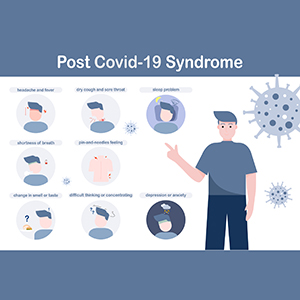Efficacy of a rehabilitation protocol on pulmonary and respiratory muscle function and ultrasound evaluation of diaphragm and quadriceps femoris in patients with post-COVID-19 syndrome: a series of cases

Submitted: January 19, 2022
Accepted: June 8, 2022
Published: June 20, 2022
Accepted: June 8, 2022
Abstract Views: 2225
PDF: 778
Publisher's note
All claims expressed in this article are solely those of the authors and do not necessarily represent those of their affiliated organizations, or those of the publisher, the editors and the reviewers. Any product that may be evaluated in this article or claim that may be made by its manufacturer is not guaranteed or endorsed by the publisher.
All claims expressed in this article are solely those of the authors and do not necessarily represent those of their affiliated organizations, or those of the publisher, the editors and the reviewers. Any product that may be evaluated in this article or claim that may be made by its manufacturer is not guaranteed or endorsed by the publisher.
Similar Articles
- Gianfranco Beghi, Antonio De Tanti, Paolo Serafini, Chiara Bertolino, Antonietta Celentano, Graziella Taormina, Monitoring of hospital acquired pneumonia in patients with severe brain injury on first access to intensive neurological rehabilitation: First year of observation , Monaldi Archives for Chest Disease: Vol. 88 No. 1 (2018)
- Mara Paneroni, Francesco D' Abrosca, Georges Fokom, Laura Comini, Michele Vitacca, Volitional rehabilitative assessments in patients admitted in a post-intensive care step down unit. A feasibility study , Monaldi Archives for Chest Disease: Vol. 87 No. 1 (2017)
- Francesco Giallauria, Lucrezia Piccioli, Giuseppe Vitale, Filippo M. Sarullo, Exercise training in patients with chronic heart failure: A new challenge for Cardiac Rehabilitation Community , Monaldi Archives for Chest Disease: Vol. 88 No. 3 (2018)
- Halil Yanardag, Cuneyt Tetikkurt, Muammer Bilir, Clinical and prognostic significance of muscle biopsy in sarcoidosis , Monaldi Archives for Chest Disease: Vol. 88 No. 1 (2018)
- Marinella Sommaruga, Elisabetta Angelino, Paola Della Porta, Mara Abatello, Giacomo Baiardo, Gianluigi Balestroni, Ornella Bettinardi, Edward Callus, Chiara Ciracì, Ombretta Omodeo, Claudia Rizza, Paolo Michielin, Marco Ambrosetti, Raffaele Griffo, Roberto F.E. Pedretti, Antonia Pierobon, Best practice in psychological activities in cardiovascular prevention and rehabilitation: Position Paper , Monaldi Archives for Chest Disease: Vol. 88 No. 2 (2018)
- Roberto F.E. Pedretti, Francesco Fattirolli, Raffaele Griffo, Marco Ambrosetti, Elisabetta Angelino, Silvia Brazzo, Ugo Corrà , Nicolò Dasseni, Pompilio Faggiano, Giuseppe Favretto, Oreste Febo, Marina Ferrari, Francesco Giallauria, Cesare Greco, Manuela Iannucci, Maria Teresa La Rovere, Mario Mallardo, Antonio Mazza, Massimo Piepoli, Carmine Riccio, Simonetta Scalvini, Luigi Tavazzi, Pier Luigi Temporelli, Gian Francesco Mureddu, Cardiac Prevention and Rehabilitation “3.0â€: From acute to chronic phase. Position Paper of the ltalian Association for Cardiovascular Prevention and Rehabilitation (GICR-IACPR) , Monaldi Archives for Chest Disease: Vol. 88 No. 3 (2018)
- Massimiliano Polastri, Lara Pisani, Andrea Dell'Amore, Stefano Nava, Revolving door respiratory patients: A rehabilitative perspective , Monaldi Archives for Chest Disease: Vol. 87 No. 3 (2017)
- J.P. Heinzmann-Filho, P.J.C. Marostica, M.V.F. Donadio, Ventilatory muscle strength in cystic fibrosis patients: a literature review , Monaldi Archives for Chest Disease: Vol. 77 No. 3-4 (2012): Pulmonary series
- Francesco Giallauria, Rosa Lucci, Francesco Pilerci, Anna De Lorenzo, Athanasio Manakos, Marianna Psaroudaki, Mariantonietta D’Agostino, Alessandra Vitelli, Luigi Maresca, Domenico Del Forno, Carlo Vigorito, Efficacy of Telecardiology in improving the results of Cardiac Rehabilitation after acute myocardial infarction , Monaldi Archives for Chest Disease: Vol. 66 No. 1 (2006): Cardiac series
- Susanna Ricotti, Valentina Martinelli, Patrick Caspani, Serena Monteleone, Lucia Petrucci, Elena Dalla Toffola, Catherine Klersy, Changes in quality of life and functional capacity after lung transplantation: A single-center experience , Monaldi Archives for Chest Disease: Vol. 87 No. 3 (2017)
You may also start an advanced similarity search for this article.

 https://doi.org/10.4081/monaldi.2022.2206
https://doi.org/10.4081/monaldi.2022.2206





